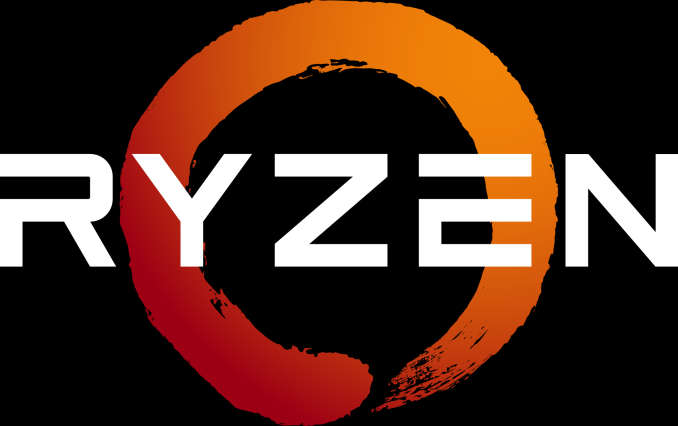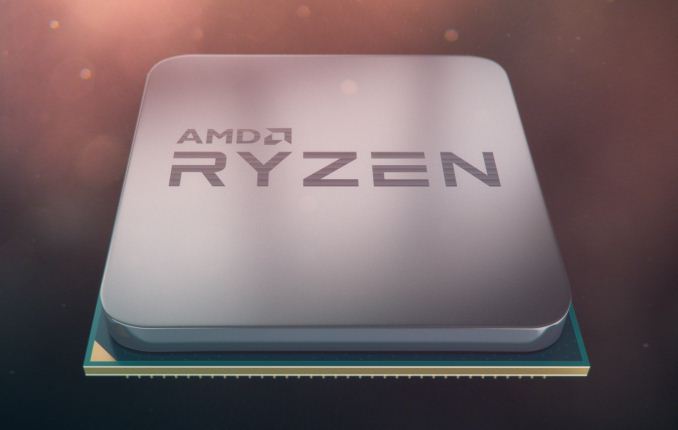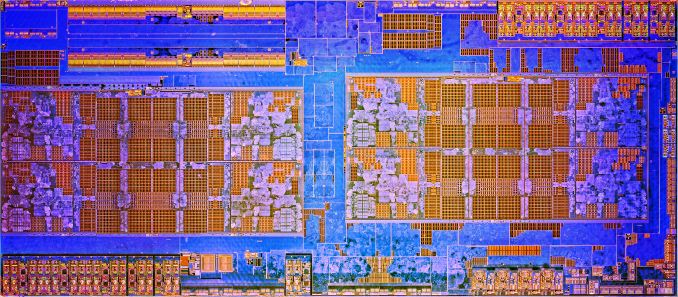AMD Launches Ryzen: 52% More IPC, Eight Cores for Under $330, Pre-order Today, On Sale March 2nd
by Ian Cutress on February 22, 2017 9:00 AM EST
The biggest x86 launch for AMD in five years is today: Ryzen is here. As always before a major launch, AMD gives a ‘Tech Day’ for relevant press and analysts, and through this event AMD’s CEO, Dr. Lisa Su lifted the lid on one of the most anticipated products in the semiconductor industry. AMD knows how to control the level of enthusiasm for its fans, and today is the end result, with processors going on pre-order from major retailers today at 1pm EST, ready for a general hard launch on March 2nd.
In a similar vein to launches of recent smartphones, AMD is doing a staggered announcement/launch with the products on their new microarchitecture. Where Samsung/Apple might give all the details for a product a few weeks before it’s available to buy, today on February 22nd marks the day where AMD is giving consumers information about Ryzen, and specifically the Ryzen 7 family of eight-core products. All the information today is from AMD, and AMD’s internal testing, and pre-orders also start from today for users ready to put down their money for a launch day part. Reviews of the CPUs, as well as when the CPUs will ship to customers, is on March 2nd. This also happens to be right in the middle of two annual shows, Game Developer Conference (GDC) and Mobile World Congress (MWC), making the time between receiving pre-launch samples and being able to provide independent verification of AMD’s performance claims relatively frantic. We’ll do our best!
The Ryzen Family
With a new processor launch, naming the parts and positioning them within the market is critical. So with Ryzen, the processor stack will be split into three based on performance and price: Ryzen 7 at the high end, Ryzen 5 in the middle, and Ryzen 3 for more price-conscious consumers. Both Ryzen 5 and Ryzen 3 are set to be launched later, and Ryzen 7 is the first portion of the family to be released.
Ryzen 7 will have three CPUs to start, all having eight cores and supporting simultaneous multi-threading:
- Ryzen 7 1800X: 8C/16T, 3.6 GHz base, 4.0 GHz turbo, 95W, $499
- Ryzen 7 1700X: 8C/16T, 3.4 GHz base, 3.8 GHz turbo, 95W, $399
- Ryzen 7 1700: 8C/16T, 3.0 GHz base, 3.7 GHz turbo, $329
Ryzen 7 1800X will be the high-end part, featuring a base clock of 3.6 GHz and a turbo of 4.0 GHz, within a TDP of 95W, and for $499. Next to this is Ryzen 7 1700X, launching at $399, with a base/turbo of 3.4/3.8 GHz. The final part for the launch is the Ryzen 7 1700, providing eight cores and sixteen threads for $329 at 3.0/3.7 GHz frequencies.
Processors will initially be available for pre-order from 185 retailers and OEMs worldwide, either as individual parts or pre-built systems.
What, not 40% IPC? 52% IPC??
Enthusiasts and analysts use the term IPC, or ‘Instructions Per Clock’, as a measure of how much the underlying microarchitecture improves from generation to generation. Two decades ago, a good design on a smaller node could net a healthy double-digit gain, whereas in recent years 5-10% gain has become the norm. When AMD initially announced that the new Zen microarchitecture they were developing was aiming for a 40% IPC gain, despite the low IPC they were starting from, users remained skeptical. AMD rehired Jim Keller to work alongside long-term AMD architect Mike Clark and produce a team with several goals in mind: high-performance x86, simultaneous multithreading, and a product to be relevant in the computing, PC, server and mobile space again. So despite this, 40% IPC always seemed a somewhat lofty goal, because Bulldozer was so underwhelming, and despite this low starting point. For the Ryzen launch today, AMD is stating that the final result of that goal is a 52% gain in IPC.
This is something we will need to test in due course!
The Ryzen Silicon, and the Future
AMD pointed out that the new 8-core silicon design runs 4.8 billion transistors and features 200m of wiring. Through previous announcements we’ve examined parts of the microarchitecture including cache sizes, threading, front-end/back-end design, and so on.
AMD Zen Microarchiture Part 2: Extracting Instruction-Level Parallelism
AMD Gives More Zen Details: Ryzen, 3.4 GHz+, NVMe, Neural Net Prediction, & 25 MHz Boost Steps
AMD’s CEO was keen to point out that this is a from-scratch design for AMD, using the knowledge gained from features developed for previous products but ultimately under the hood it looks like ‘a typical x86 high-performance core’, with AMD-specific features and tweaks. We were told that AMD’s roadmap extends into the multi-year range, so while the focus for 2017 will be on this family of products, back at HQ the next two generations are in various stages of development.
BENCHMARKS PLEASE
So despite the 82+ motherboards going to be available, 19 initial PC system builders moving into 200+ through the first half of 2017, the big question on everyone’s lips is how exactly does it perform?
Well, AMD gave us the following numbers:
AMD's benchmarks showed that the top Ryzen 7 1800X, compared to the 8-core Intel Core i7-6900K, both at out-of-the-box frequencies, gives an identical score on the single threaded test and a +9% in the multi-threaded test. AMD put this down to the way their multi-threading works over the Intel design. Also, the fact that the 1800X is half of the price of the i7-6900K.
In a similar vein, again with the Cinebench 15 multi-threaded test, the Ryzen 7 1700X scores over and above the Core i7-6800K (its price competition) and higher than the Core i7-6900K which costs 2.5 times as much.
We’ll tell you what our benchmarks say, with official retail processors. But you will have to wait until March 2nd. Sorry.





















386 Comments
View All Comments
Gastec - Thursday, February 23, 2017 - link
Edit: Intel Core i7-7700K: 4C/8TOutlander_04 - Thursday, February 23, 2017 - link
Core for core, thread for thread the AMD will trail the last two generations of intel socket 1151 in games . Atleast it looks that way in the low resolution poorly threaded games comparisons.But generally it wont matter . So many people just look at a bigger fps number and think its better. Often it is not . And monitor technology is one of the reasons why.
A 60 Hz monitor can only ever display 60 fps . If two systems with rival processors are outputting 80 fps and 120 fps respectively then the user experience is identical . Both actually see 60 fps . All the other frames are dropped by the monitor and never displayed at all.
This is why even the FX processors already available are almost always a match for the current intel i5's . Yes there are situations where intel have the advantage, but they are rare enough to not bother with too much . And especially not when you are considering optimizing costs.
Ryzen is a clear step up though and those running really high resolution monitors, streaming and encoding will do well with one.
For those wanting to push 144 HZ to a 1080p monitor then intel may remain the better choice.
The benchmarks are coming ... then we will know
prisonerX - Thursday, February 23, 2017 - link
Games are not single threaded, unless you only play stuff from the 1990's.PixyMisa - Thursday, February 23, 2017 - link
Ryzen is about level with Broadwell on IPC.So on single-thread workloads, the 1700X should be about equal to the 4770K, 10% behind the 6700K, and 15% behind the 7700K.
For 1600X or 1800X, that would be 5% ahead of 4770K, 5% behind 6700K, and 10% behind 7700K.
Of course, that will vary by application. Ryzen has half the AVX2 performance per core of Skylake, but double the L2 & L3 cache.
tamalero - Thursday, February 23, 2017 - link
Those processors looks gorgeous for personal servers.Haawser - Thursday, February 23, 2017 - link
OCUK has gotten the R7 1700 to 4GHz with OC (all cores).That's 6900K performance for 1/3rd of the price, never mind 1/2...
R.I.P Intel E-series. There is no coming back from that.
msroadkill612 - Friday, February 24, 2017 - link
Well yes, this IS a PC~site, but no one I see mentions a fresh major app/market, in the form of autonomous EVs etc.I hear AMD have a lot going for them as a smart, cheap and powerful platform to base them on.
History is full of examples of booms waiting in the wings for some pre-requisite tech development. electricity begat many inventions, as did oil e.g.
A historic such shift is relatively recent battery tech and economics. Been around since ~2005, but not cheap and mainstream.
At a guess, they have improved by a factor of ~4-10x in each of; weight, cost, dis/charge rate, longevity, ..... This isnt incremental improvement. Its a still evolving revolution.
This is a major paradigm shift in what is doable electrically using batteries.
So I am just saying, in the context of AMDs future?, their appeal to EV makers e.g ought be considered.
maybe auto makers will just put a pc mobo in their cars and be done with inferior proprietary bespoke approaches to increasingly smart cars.
I heard AMD have done well with console makers, as their platform gets their game products to market faster. Its a similar environment to cars ATM.
Predictive adaptive cruise control (ACC) really is a "dealbreaker must have" for many savvy car buyers right now. the rewards are huge for the winner, but they are very slow to make it a mainstream fairly priced option, if at all.
its a tough job to do it right, it takes some AI. maybe its time cars had a PC integrated? If so, does amd have an edge?
Gastec - Friday, February 24, 2017 - link
Your comment made me remember about the last of the Adaptive Cruisers, Antaeus from Hostile Waters :)eddiechi - Friday, February 24, 2017 - link
Intel Holding back?
Intel's brand cache has been eroding for years now, the erosion was accelerated when CEO Krzanich took reign and has forever proclaimed success on Moore's Law..... Things have deteriorated severely at Intel.......
Intel's brand cache has been eroding for years now, the erosion was accelerated when CEO Krzanich took reign and has forever proclaimed success on Moore's Law.....
Things have deteriorated severely at Intel. Internal sources at Intel have stated the climate has been awful and not just due to recent layoffs of 12,000 or 11% of workforce. In light of many recent news headlines and not just Ryzen, Intel is probably in the most delicate situation it has ever had to face.
CEO Brian Krzanich has lead Intel into a slow death spiral and it hurts me to admonish my croation brotheren. Back in 2006 Intel had about a 50% market share with AMD and has watched it increase dramatically every year since to now about 80/20 but years of bad decisions and throwing good money after bad have caught up to the CEO with his pants down. Throwing $8 Billion at Mcafee and $17 Billion at Altera and wasted Billions trying to crack the mobile market with the “contra-revenue” Bay Trail processor where Intel basically tried to bribe tablet makers into using Bay Trail Processors at substantial loss for Intel.
All these casualties has had the CEO reducing costs at the greater cost of unexpected consequences. The delay on 10nm has just increased, worse yet Canon Lake is not expected to feature any significant architectural improvements…. The CEO mistakenly doubled down on the hope that AMD not competing with them - so those that think “Intel has been holding back” are severely mistaken, there is the rumbling of a major earthquake going on right now under Intel’s feet……. Management has been coalescing to get momentum to push CEO out and bring in Murthy Renduchintala. Krzanich has lead a disaster and has basically and systematically undressed Intel, R&D is screwed and has left a void until well into 2019, CEO had completely underestimated the possibility of an AMD comeback while trying to continue with his Moore’s Law mantra which has been basically tossed out window with end of tick/tock procedures followed for almost a decade.
CEO has sat by idly after their 2016 Q4 earnings call from CFO stated product issues have limited profitability mainly due to fault with Atom c2000 family that bricks devices and had to set aside a pot of cash to deal with problems and recently announced Atom C2000 chip line contains a clock flaw and the recently hired COO Kim Stevenson resigned after just taking helm of division that leads PC business in August.
Intel has been in no position to “hold back” recently with all the internal problems and now AMD has just put them way behind the 8-ball. Should expect a plethora of changes at Intel shortly after Ryzen is released, writing has been on wall way before recent revelations of potential AMD comeback….. adding to issues of AMD resurgence is that Intel is also in the crosshairs of sleeping giant Qualcomm.
Kaby Lake brought in “new” PAO process, Process - Architecture – Optimization….. there is no underlying change to the microarchitecture, Intel is not promoting any performance difference with the previous generation, they are however promoting better efficiency and creating a bit more headroom for OC’ing. Moore’s Law has driven Intel computing for a decade and has now forced Intel to dump tick/tock at most inopportune time with CEO not seeing AMD coming and with no immediate recourse at hand and most likely not until into 2019 will Intel be able to do anything but marketing tactics disguised by slashing prices.
Intel has enjoyed their monopoly for years and seems to have rested on it’s laurels and market superiority for too long but they have not been holding back. Anandtech just released article last week about 8th gen continuing on 14nm and 10nm pushed back to late 2017 or 2018….. Kaby Lake, Coffee Lake, Cannonlake, Ice Lake or Tigerlake will not help Intel if the AMD hype comes to fruition next week.
eddiechi - Saturday, February 25, 2017 - link
and the pressure has already hit Intel and AMD hasn't been released yet for independent reviews...... INTEL JUST ANNOUNCE more than a dozen price cuts starting with $300 off 6950X.......Here we go.......................